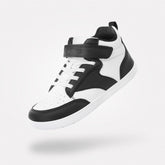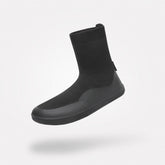Your Body Is Trying to Tell You Something
These simple actions take less than a minute but could completely change the way you think about shoes. Grab a mirror, your worn-out shoes, or even just a tissue—and try the tests below:
Quick Self-Checks:
Test 1: Examine your old shoes
Place them on a flat surface. Are the soles worn down more on one side?
Test 2: Stand in front of a mirror
Check your shoulders or hips—are they noticeably higher on one side?
Test 3: Step barefoot onto a tissue or paper
Does your footprint completely fill the space? Can you see an arch?
Test 4: After wearing thick-soled or supportive shoes all day
Do your feet feel sore, your calves ache, or you just want to take your shoes off and relax?
Noticing something off?
You're not alone. Many people experience subtle but impactful body imbalances—often caused or worsened by the shoes they wear.
(Note: The following content is for educational purposes only and should not be considered medical advice. Please consult a healthcare professional if you experience ongoing discomfort.)
Worn-Out Soles: The Footprint of Your Body Mechanics
Your shoe soles quietly record how you move and where your body takes the most impact.
How to self-check:
-
Look at your well-loved shoes. Are they unevenly worn side to side or front to back?
-
Take periodic photos and compare the wear patterns over time.
Common wear patterns & what they suggest:
-
Outer heel wear: You may walk with a heel-dominant or supinated gait.
-
Inner forefoot wear: Indicates overpronation—can strain knees and hips.
-
Asymmetrical wear: Could point to leg length discrepancy or shifted body weight.
Studies show that over 65% of people with severe sole wear imbalance also show signs of asymmetrical gait or compensatory movement.

Potential impacts:
-
Long-term stress on one knee or hip, leading to bursitis or cartilage damage
-
Misalignment that can reach the spine, contributing to shoulder and neck tension
-
Reinforcement of improper movement patterns if issues go unaddressed

Common misconceptions:
-
Blaming the shoe quality instead of noticing how your body is using it
-
Continuing to wear old shoes for casual activities, which worsens the imbalance
-
Choosing new shoes based on looks or short-term comfort without checking old wear
Relief strategies:
-
Film yourself walking or get a professional gait analysis
-
Switch to shoes with clearer ground feedback and flatter soles
-
Try basic awareness drills like barefoot balancing or walking on uneven ground

Uneven Legs: The Root of Asymmetrical Movement
Body imbalance isn't just cosmetic. A slight height difference in hips or shoulders can change how your muscles and joints behave all day long.

What is functional leg length discrepancy? It's not that your bones are actually different lengths—but rather a result of pelvic tilt, spinal curves, or muscular imbalances. Over 60% of people may have a difference of 0.5 to 1.5 cm.
Common effects:
-
Pelvic tilt leading to tension on one side, slack on the other
-
One knee bearing more load than the other, increasing injury risk
-
Foot and lower back pain due to compensatory gait
-
Higher injury rate during exercise due to uneven muscle activation

Misconceptions:
-
Thinking it's a "born with it" issue with no solutions
-
Using inserts to artificially raise one side, which can worsen alignment over time
-
Believing ultra-cushioned shoes mask the problem (they often hide the symptoms)
Relief strategies:
-
Strengthen your core and glutes to stabilize the pelvis
-
Try zero-drop shoes that don’t shift your natural posture
-
Increase body awareness in daily movement, especially while standing or walking

Foot Arch Type: Your Body's Foundation
Think of your foot arch as your body's natural shock absorber. Whether flat (low arch) or rigid (high arch), deviations can ripple upward through your posture.
Quick self-check:
-
Step barefoot onto paper or tile with a wet foot—if the entire print shows, it's likely a flat arch; if the midfoot is missing, it may be a high arch.
-
View your ankle from behind—collapsing inward suggests flat feet; excessive arching suggests a high arch.

Impact of different arch types:
Flat feet:
-
Heavier, less elastic step—like slapping the ground
-
Full-foot pressure can cause calluses, corns, or nerve compression
-
Knees roll inward, hips rotate out, contributing to misaligned posture
-
Especially risky if not addressed in childhood development
72% of adults with flat feet report some knee or back discomfort (Clinical Biomechanics, 2021)
High arches:
-
Pressure loads at heel and forefoot—poor shock absorption
-
Rigid gait and increased risk of toe deformities
-
Smaller contact area can impair balance and increase injury risk
Misconceptions:
Flat feet:
-
Relying on arch support insoles instead of strengthening foot muscles
-
Believing nothing can improve flat feet
-
Ignoring early signs in children during key development years
-
Thinking shoes alone can fix the issue

High arches:
-
Mistaking high arches for "ideal feet"
-
Using soft inserts to mask pain without addressing mechanics
-
Overlooking the need for foot stability and core control
Relief strategies:
-
Transition to barefoot shoes to reawaken foot sensation and muscle use
-
Wide toe box: encourages natural spreading for lateral arch stability
-
Thin soles: provide ground feedback to stimulate foot activity
-
Use as a training platform rather than a quick fix
-

-
Foot exercises like towel grabs, toe lifts, or single-leg balance

Fatigue After Wearing Cushioned Shoes: Comfort ≠ Function
When we say "thick-soled shoes," we don’t just mean high soles—we mean shoes that block sensation. The kind that feel like clouds… but numb your awareness of the ground.
Try this:
-
Take off your shoes and stand barefoot. Can you feel your toes grip the floor?
-
Put your shoes back on. Do your feet instantly feel less present?
How your body may respond:
-
Sensory disconnection: Feet can’t communicate with the ground
-
Muscle inactivity: Feet and calves stop doing their job
-
Dull stride: You shuffle rather than flow, wasting energy
-
Compensatory movement: Other joints overwork to keep you stable

Misconceptions:
-
Assuming "more cushion = less effort"—you may just feel less tired, not be more efficient
-
Blaming fatigue on long walks, not the shoes themselves
-
Believing extra support guarantees safety—in reality, it may reduce your body’s independence
Relief strategies:
-
Try shoes that bring you closer to the ground and re-engage foot function
-
Let your toes spread naturally and re-activate underused foot muscles
-
Practice awareness:
-
Stand barefoot and find your balance point
-
Walk with intentional knee lifts
-
Take a barefoot stroll on grass or sand
-

Shoes Are Tools—And Translators for Your Body
We walk every day, yet rarely listen to the signals from our feet.
This article guided you through a few simple self-tests:
-
From uneven shoulders in the mirror to the wear patterns on your soles
-
From the arch in a damp footprint to the quiet fatigue of a soft shoe
You might’ve discovered something new—or realized an old issue wasn’t so minor.
These aren’t all-or-nothing problems, and no shoe alone can "fix" your posture. They're reflections of your habits over time. But shoes do matter. They’re the interface between your body and the ground.
Rethink your shoes—and you just might rediscover your body.





















